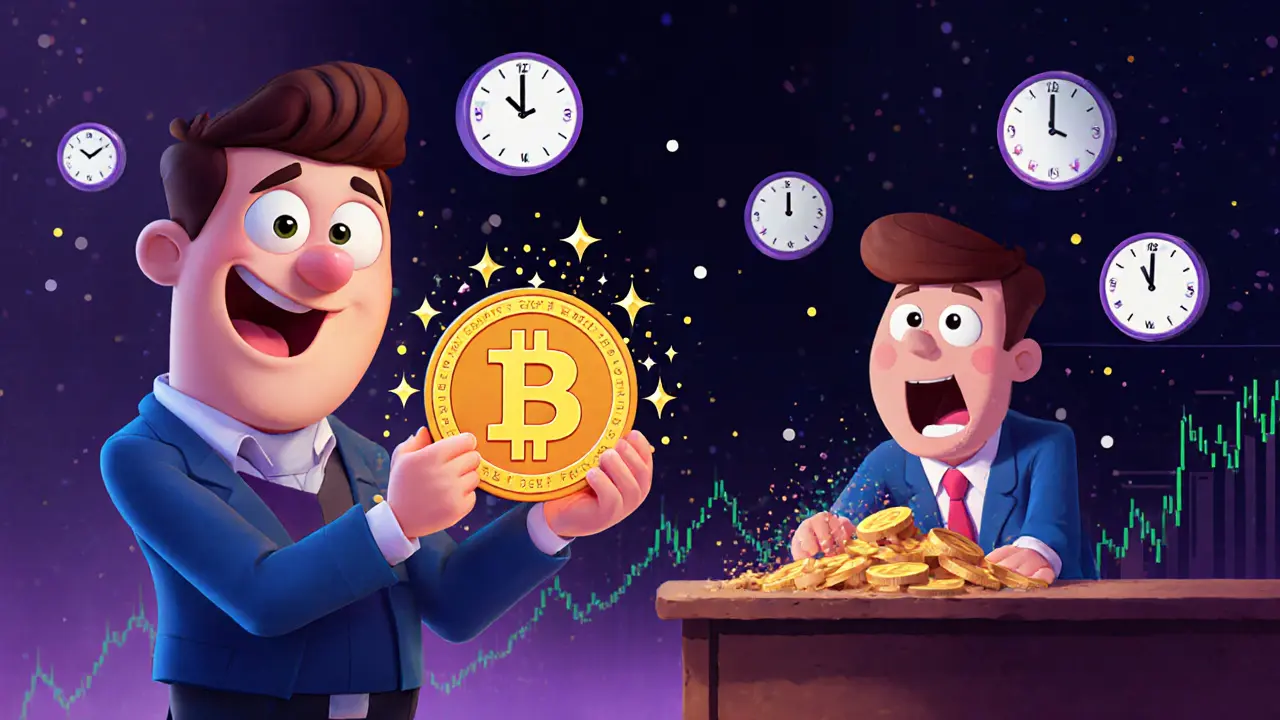Margin Trading Calculator
This calculator helps you understand how leverage impacts potential profits and losses in cryptocurrency margin trading. Enter your trade parameters to see realistic scenarios based on the article's principles.
Trade Summary
Total Position Value: $0
Liquidation Price: $0
Funding Costs: $0
Current Value: $0
Profit/Loss: $0
Risk Level: Medium Risk
Warning: Margin trading can result in total loss of your initial investment. Never trade with money you cannot afford to lose.
Margin trading in cryptocurrency lets you borrow money to trade bigger positions than your account balance allows. It’s not magic-it’s leverage. And like any tool, it can build wealth or destroy it fast. If you’ve ever seen someone turn $1,000 into $5,000 in a week and wondered how, margin trading is often the answer. But if you’ve also seen someone lose everything in one bad trade, that’s margin too.
How Margin Trading Works
You start by depositing your own money-this is called your margin. The exchange then lends you extra funds based on a multiple, called leverage. For example, with 5x leverage, your $1,000 becomes $5,000 to trade with. You don’t own more Bitcoin or Ethereum-you just control a larger position.
This works because the exchange holds your $1,000 as collateral. If the trade goes against you, they can take that money to cover losses. If it goes your way, you keep the profit after paying back the loan and interest.
Let’s say you buy 0.1 BTC at $60,000 using 5x leverage. You put up $1,200 (your margin), and the exchange lends you $4,800. Total position: $6,000. If BTC rises to $66,000, your position is now worth $6,600. You sell, pay back the $4,800 loan, and walk away with $1,800. That’s a 50% profit on your $1,200. Without leverage, you’d have made only $100.
But if BTC drops to $54,000? Your position is now worth $5,400. You owe $4,800. After paying it back, you’re left with $600. That’s a 50% loss on your margin. At $52,000? You’re wiped out. And if it drops further, you might owe money.
Long vs. Short Positions
Margin trading isn’t just about betting prices go up. You can also go short.
A long position means you borrow money to buy crypto, expecting the price to rise. You sell later to repay the loan and pocket the difference.
A short position means you borrow the actual crypto (not money), sell it immediately, and wait for the price to drop. Then you buy it back cheaper, return the borrowed amount, and keep the difference.
Shorting is harder to understand but just as powerful. If you short 0.1 BTC at $60,000 with 5x leverage and it falls to $54,000, you buy it back for $5,400, return it, and keep $600 profit. Same math as going long-but inverted.
Leverage Ratios and Risks
Exchanges offer different leverage levels. Most spot margin trading runs between 2x and 10x. Some futures platforms go up to 125x. Higher leverage = higher reward potential, but also higher risk of total loss.
Here’s what 10x leverage really means: a 10% move against you wipes out your entire margin. A 5% move? Half your money gone. That’s why even small price swings can trigger liquidation.
Liquidation happens when your account balance falls below the exchange’s minimum required collateral-the maintenance margin. This can be as low as 0.5% or as high as 50%, depending on leverage and asset. For example, with 10x leverage on Bitcoin, a 10% drop triggers liquidation. With 5x, it’s a 20% drop.
And it’s not always clean. During the May 2021 Bitcoin crash, over $1 billion in margin positions were liquidated in 24 hours. Many traders didn’t just lose their collateral-they owed money to the exchange.

Funding Rates and Hidden Costs
It’s not just about price moves. You pay to borrow. Every 4 or 8 hours, exchanges charge a funding rate. It’s usually small-0.01% to 0.1%-but it adds up.
If you hold a position for days or weeks, those tiny fees can eat into your profits or turn a winning trade into a loser. Novice traders often ignore this until it’s too late. One Altrady survey found 28% of beginners lost money because they didn’t account for funding costs.
Some platforms also charge flat borrowing fees based on asset demand. ETH might cost more to borrow than BTC during a rally. These fees aren’t always obvious until you open a trade.
Margin Trading vs. Spot Trading vs. Futures
Many confuse margin trading with other crypto trading types. Here’s how they differ:
- Spot trading: You buy crypto with your own money. No borrowing. No leverage. No liquidation risk beyond your initial investment.
- Margin trading (spot margin): You borrow funds to buy more crypto. You own the asset. Leverage usually capped at 10x. Fees apply. Liquidation possible.
- Futures trading: You bet on price without owning the asset. Leverage can be 125x. No collateral in the same way-only maintenance margin. No funding fees, but contract expirations and rolling costs exist.
Margin trading is closer to spot trading-you end up holding the actual crypto. Futures are pure speculation. You don’t own anything. That’s a big difference for tax and custody purposes.
Who Should Do It?
Margin trading is not for beginners. Not even close.
Platforms like Bitpanda and Gemini say you need at least 6-12 months of spot trading experience before even considering margin. Why? Because you need to understand:
- How candlesticks and support/resistance work
- How volatility spikes happen
- How to set stop-losses properly
- How to read order books and liquidity zones
Reddit users who’ve lost everything often say the same thing: “I didn’t know liquidation prices could change so fast.” Or: “I thought I had time to wait it out.”
Experienced traders recommend:
- Never risk more than 5% of your total portfolio on one margin trade
- Always set stop-losses 10-15% below your entry point
- Use only 3x-5x leverage, never 10x+
- Never trade with money you can’t afford to lose
One trader on CryptoSlate said: “I lost three times in 2023. Each time, I thought I’d learned. Then I realized I hadn’t. I stopped trading margin for six months. Now I only do 3x on clear setups.”

Regulation and Availability
Margin trading is legal in the U.S., but many exchanges don’t offer it. Coinbase shut down its margin feature in 2025 because of “strict regulatory requirements.” The SEC and CFTC have been cracking down on unregulated lending and leverage products.
In Europe, MiCA regulations cap retail leverage at 2x-5x. In Asia, exchanges like Binance and Kraken still offer up to 10x for spot margin, but only to non-U.S. users. Crypto.com and others now restrict margin trading to users outside the U.S.
Why the crackdown? In 2024, the IMF warned that unregulated crypto margin trading poses “systemic risks” during market crashes. When thousands of leveraged positions liquidate at once, it creates cascading sell-offs that crash prices further.
What’s New in 2025
Exchanges are adding safeguards. Binance introduced dynamic liquidation thresholds in January 2025-meaning liquidation prices adjust during high volatility to avoid panic sell-offs. Kraken launched margin insurance pools to reduce auto-deleveraging, where profitable traders lose money to cover others’ losses.
Bitpanda rolled out auto-hedging in March 2025, which automatically closes part of your position if the market moves too far against you. These tools help, but they’re not magic. They don’t replace discipline.
Industry analysts predict only 3-4 major exchanges will survive the next wave of regulation by 2027. Margin trading isn’t going away-but it’s becoming harder to access, especially for retail traders in the U.S.
Final Reality Check
Margin trading can make you rich. But it’s more likely to make you poor.
It’s not a shortcut. It’s a trap for the unprepared. The same tools that turn $1,000 into $5,000 can turn it into -$2,000. You’re not just betting on price-you’re betting on your own discipline, timing, and emotional control.
If you’re new to crypto, stick to spot trading. Learn how markets move. Build experience. Understand volatility. Then, if you’re still interested, start with 2x leverage. Use only 1-2% of your portfolio. Set stop-losses. Track funding rates. And never, ever trade with rent money.
Margin trading isn’t about being smart. It’s about being patient. And most people aren’t.

Joy Whitenburg
November 12, 2025 AT 20:47Phil Bradley
November 12, 2025 AT 23:57William Moylan
November 13, 2025 AT 05:21Ainsley Ross
November 13, 2025 AT 14:06Michael Faggard
November 14, 2025 AT 18:27Elizabeth Stavitzke
November 15, 2025 AT 01:05Laura Hall
November 16, 2025 AT 14:12Douglas Tofoli
November 17, 2025 AT 19:27Wayne Dave Arceo
November 19, 2025 AT 17:15Brian Gillespie
November 20, 2025 AT 13:28Michelle Elizabeth
November 21, 2025 AT 14:49Joanne Lee
November 22, 2025 AT 00:39